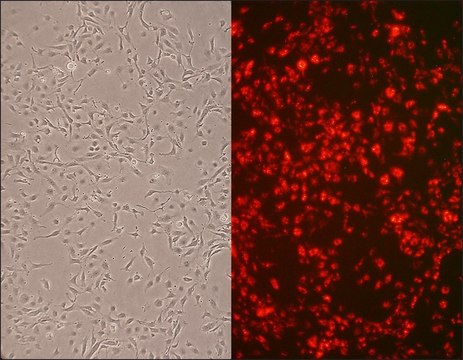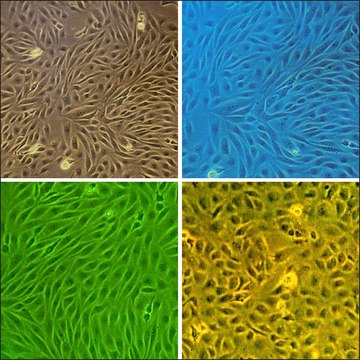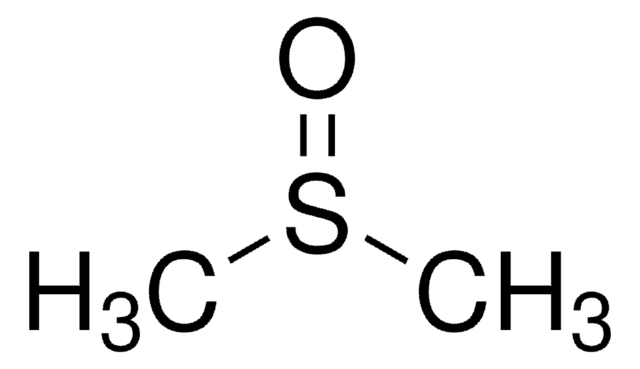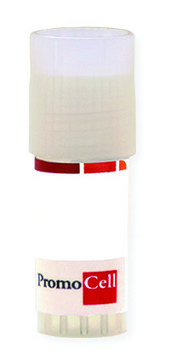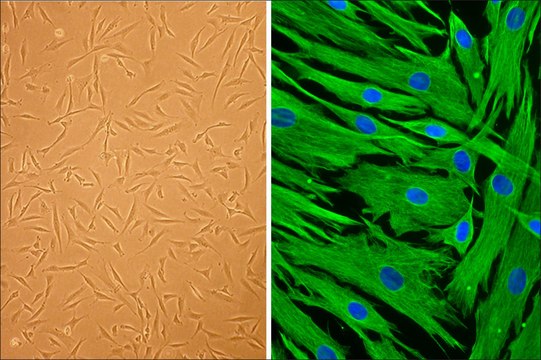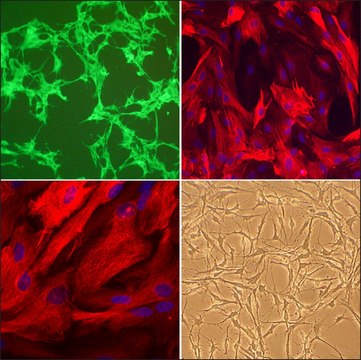R840-05A
Rat Brain Microvascular Endothelial Cells: RBMVEC, adult
Synonym(s):
RBMVEC cells
Sign Into View Organizational & Contract Pricing
All Photos(1)
About This Item
UNSPSC Code:
41106514
NACRES:
NA.81
Recommended Products
biological source
rat brain (Sprague Dawley, adult)
Quality Level
packaging
pkg of 500,000 cells
manufacturer/tradename
Cell Applications, Inc
growth mode
Adherent
morphology
Endothelial
technique(s)
cell culture | mammalian: suitable
shipped in
dry ice
storage temp.
−196°C
General description
Lot specific orders are not able to be placed through the web. Contact your local sales rep for more details.
RBMVEC from Cell Applications, Inc. provide an excellent model system to study many aspects of endothelial function and disease, especially those related to the blood-brain barrier (BBB), including interactions between neurons, astorcytes and endothelial cells, brain cognitive function, search for therapeutic modulators, and develop novel drug delivery methods for crossing the BBB.
RBMVEC from Cell Applications, Inc. have been utilized in a number of research publications, for example to:
RBMVEC from Cell Applications, Inc. provide an excellent model system to study many aspects of endothelial function and disease, especially those related to the blood-brain barrier (BBB), including interactions between neurons, astorcytes and endothelial cells, brain cognitive function, search for therapeutic modulators, and develop novel drug delivery methods for crossing the BBB.
RBMVEC from Cell Applications, Inc. have been utilized in a number of research publications, for example to:
- Serve as a gold standard control for endothelial markers VE-cadherin and CD31 expression (Johansson, 2009)
- Demonstrate a better brain penetration of cardiovascular and anti-stroke drugs Tanshinones IIA and IIB and Cryptotanshinone in the presence of PgP or MRP1/2 inhibitors (Chen, 2007; Yu, 2007; Zhi-Wei, 2007) or by using PEGylated gold nanoparticles (Etame, 2011)
- Show that removal of excess glutamate from the blood by glutamate oxaloacetate transaminase correlates to a decrease in brain glutamate levels and confers neuroprotection against ischemic stroke (Campos, 2011)
- Assess, along with Rat Astrocytes (RA) also obtained from Cell Applications, Inc., neuroprotective capabilities of bioenergy stabilizers in an in vitro model of stroke (Liu, 2013)
- Show that bile acids cause activation of Rac1 and phosphorylation of occluding, explaining increased permeability of the blood brain barrier seen during obstructive cholestasis (Quinn, 2014)
- Demonstrate that saquinavir-associated dementia in HIV-positive patients is exacerbated by smoking due to the BBB disruptive effects of both nicotine and saquinavir, mediated by decrease in Notch-4 expression and increase in ROS (Manda, 2010)
- Show that treatment with connexin43 mimetic peptide which transiently blocks gap junction function, reduces vascular leak and can be used to treat of central nervous system ischaemia (Danesh-Meyer, 2012)
- Demonstrate that oxygen and glucose deprivation increase ROS, cytochrome c levels and caspase-3 activity, induce tight junction disruption and actin stress fiber formation, leading to BBB break down (Alluri, 2013)
- Investigate the interactions between neurons, astorcytes and endothelial cells by showing that exposure to metabolic stress induces tissue-type plasminogen activator release from neurons which induces AMPK activation, membrane recruitment of GLUT1, and GLUT1-mediated glucose uptake in astrocytes and endothelial cells, followed by the synthesis and release of lactic acid from astrocytes, and that the uptake of this lactic acid via the monocarboxylate transporter-2 promotes survival in neurons (An, 2013)
- Study the proapoptotic and anti-angiogenic role of p75NTR in choroidal neovascularization (Tahiri, 2013)
Cell Line Origin
Brain
Application
Endothelial vessel function, cell signaling, angiogenesis.
Components
Rat Brain Endothelial Cell Basal Medium that contains 10% FBS and 10% DMSO
Quality
Each lot was tested for proper morphology, Population Doublings, Negative for HIV, Hepatitis B, Hepatitis C, mycoplasma, bacteria, and fungi.
Preparation Note
- 2nd passage, >500,000 cells in Rat Brain Endothelial Cell Basal Medium that contains 10% FBS and 10% DMSO
- Can be cultured at least 16 population
Subculture Routine
Please refer to the RBMVEC Culture Protocol.
Storage Class Code
10 - Combustible liquids
WGK
WGK 3
Flash Point(F)
Not applicable
Flash Point(C)
Not applicable
Regulatory Information
动植物来源生物产品
Choose from one of the most recent versions:
Certificates of Analysis (COA)
Lot/Batch Number
It looks like we've run into a problem, but you can still download Certificates of Analysis from our Documents section.
If you need assistance, please contact Customer Support.
Already Own This Product?
Find documentation for the products that you have recently purchased in the Document Library.
Nicholas Sitaras et al.
The American journal of pathology, 185(2), 581-595 (2014-12-06)
Ischemic retinopathies are characterized by sequential vaso-obliteration followed by abnormal intravitreal neovascularization predisposing patients to retinal detachment and blindness. Ischemic retinopathies are associated with robust inflammation that leads to generation of IL-1β, which causes vascular degeneration and impairs retinal revascularization
Our team of scientists has experience in all areas of research including Life Science, Material Science, Chemical Synthesis, Chromatography, Analytical and many others.
Contact Technical Service
